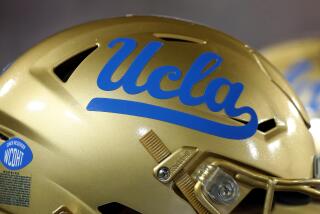University Fee Increases
- Share via
The Times questions fee increases for the University of California (editorial, Nov. 26) while failing to acknowledge the widespread spending cuts we have implemented to address the worst fiscal crisis since the Great Depression.
State general fund appropriations for UC have fallen $250 million in two years, from $2.13 billion in 1990-91 to $1.88 billion in 1992-93--a 12% cut. This does not include what would have been required to meet the rising costs of inflation and enrollment growth. By that measure, UC is short about $700 million.
State funding is critical to UC’s educational program. At UCLA, while state monies finance only one-third of our overall operating budget, they provide a full two-thirds of our core teaching and research program budgets. Other services, such as the medical center, student housing, parking and transportation, are largely self-supporting through user fees.
The UC system faced three untenable choices to meet this shortfall. We could have cut expenditures to the point of cannibalizing academic programs and services, closed the door to thousands of eligible students, or raised student fees to recoup all that was lost in state appropriations. Our response was none of the three extremes. Instead, we combined significant spending cuts with some increases in fees, and we expanded the pool of financial aid to preserve access for needy students.
This year student fees rose $550, generating about $15 million for UCLA. Beyond that our campus cut staff and faculty expenditures by about $24 million. Staff and faculty have been denied cost-of-living salary increases for the second consecutive year, and more than 1,000 UCLA staff have taken early retirement or been laid off over the past two years.
UC’s top priority in meeting the cuts in state funding has been to maintain educational quality, particularly for undergraduates. UCLA cut its administrative expenditures an average of 14% in state funding over the past two years, compared to 4.6% for the instructional program. The chancellor’s office sustained the largest cut, about 17%.
Despite these cuts, UCLA is offering more courses this year than last, thanks to the extraordinary efforts of our faculty. Graduation rates are rising, and students are obtaining degrees in shorter time.
Student fees have risen faster than anyone would like. Yet UC remains one of the more affordable universities of comparable quality, public or private, in the U.S.
UC is considering all means to preserve its historic quality, access and affordability.
CHARLES E. YOUNG
Chancellor, UCLA
More to Read
Sign up for Essential California
The most important California stories and recommendations in your inbox every morning.
You may occasionally receive promotional content from the Los Angeles Times.










